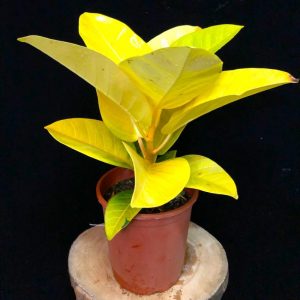The Calathea orbifolia’s oversized leaves are striped with silvery bands that are tastefully beautiful in a simple way. It’s one of those plants that triggers a must-have purchase – but Calathea orbifolia care can be a challenge if you want to keep your plant looking radiant. A South American prayer plant kept for its clean, designer-quality foliage, Orbifolia is one of the largest Calatheas. Its bold oval leaves can grow over a foot across – it makes a classic statement plant. Calatheas can be fussy and the Orbifolia is no exception. Its attractive foliage and well-balanced profile attracts smitten owners, some of whom sadly watch the lovely plant slowly disfigure itself and decline. Why? Because love is not enough. Orbifolias require high humidity and consistent soil moisture to thrive. Owners who brag about how easy it is to keep Orbifolias often fail to mention they live in a tropical area. If your home is dry, you’re at a disadvantage. There’s no need to fear a Calathea orbifolia, however, only to understand it. Give it jungle-like conditions that include warmth and moisture, and you’ll both be happy. It’s safe for pets and children: they will likely be more in danger from you if they eat it. Calathea orbifolia can be hard to find, though it’s becoming easier as their popularity grows.
Orbifolia
Orbifolia
- Scientific Name: Calathea orbifolia
- Origin: Bolivia
- Light Requirements: Medium, filtered light
- Watering: Maintain moist soil with regular watering, but do not let the soil become soggy. Use filtered, distilled or rainwater ideally.
- Soil: Well draining potting mix. A good mix is two parts peat/coir and one part perlite.
- Temperature: 65°F (18°C) to 75ºF (24ºC)
- Fertilizer: Monthly while actively growing with 1/4 strength, balanced fertilizer. Flush the soil several times per year.
- Humidity: Needs high humidity to keep foliage looking well.
- Pruning: Minimal pruning requirements. Prune old or yellowed leaves.
- Propagation: Propagate by division in late spring/early summer. Can be tricky.
- Re-Potting: Calathea orbifolia doesn’t like to be repotted too often. Only once root-bound.
- Diseases and Pests: Damp conditions can promote fungus, powdery mildew & leaf-spot, but their most deadly vulnerability is root rot. Thrips and other leaf suckers can present at times.
- Toxicity: Non-toxic to humans and animals.







